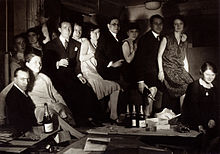Jacques-Émile Ruhlmann
Jacques-Émile Ruhlmann (born August 28, 1879 in Paris, † November 15, 1933 in Paris ) was a French interior and furniture designer . Its elegant and finely crafted furniture and interiors were among the most fashionable and luxurious elements of Parisian Art Deco in the 1920s and 1930s .
Life
The offspring of an Alsatian Protestant family who moved to Paris in 1870 worked, interrupted from military service, in his parents' painting and mirror business from 1897 and designed wallpapers and designed the first furniture designs, which he took over in 1907 after his father's death. In the same year Ruhlmann began with furniture design. In 1913, Ruhlmann's great career also began offering interior designs and exhibiting a secretary at the autumn salon .
In 1919 he teamed up with the painter Pierre Laurent and the new company "Ruhlmann & Laurent" earned an international reputation for high-quality craftsmanship and innovative design. Since he was not a carpenter himself, his furniture was made by outsourced (between 1913 and 1923 by "Haentges Frères & Fenot") or his own workshops (from 1927 he ran his own workshop divided into six floors), but always exactly according to his plans.
He used fine woods such as Macassar ebony , Ambrosia maple, American burr walnut and violet wood and provided it with inlays of ivory, tortoise shell and shagreen . Most of his works were commissioned. His style shows his love for neoclassicism of the 18th century, but towards the end of his career he also experimented with more modern designs such as furniture made of glass and chrome-plated steel. The heaviness of many of his pieces was offset by the use of legs attached halfway up a cabinet, table, or dresser, rather than being supported from below.
In 1925, an entire pavilion was dedicated to him at the Paris Art Deco exhibition , the "Art Collector's House" designed by his friend Pierre Patout . It contained a table and bookcase made of solid Macassar ebony with a metal frame, and a large armchair covered in elephant skin. In 1927, Ruhlmann designed the ballroom and the negotiating room of the Paris Chamber of Commerce and the tea room of the Île-de-France passenger ship . Ruhlmann also decorated the Élysée Palace and received other prestigious commissions. One such order was, for example, the 1929 commission from the German interior designer Eckart Muthesius for writing furniture in the Manik Bagh palace of the Indian Maharajah of Indore in his capital, Indore . It contained modular furniture made of Makassar ebony that could be assembled into shelves, display cabinets, chests of drawers or room dividers.
After his death, the company was dissolved at Ruhlmann's request.
Quotes
«Jusqu'à présent je n'ai pas songé au meuble en série. J'estime qu'il faut rallier d'abord à l'esprit modern une élite qui demeure l'arbitre du gout, sans toutefois prétendre qu'il ne faille penser qu'à elle. »
“To this day, I haven't thought about series furniture. I think that one must first assemble an elite around the modern mind who see themselves as the arbiter of taste, but without pretending that they only have to think of themselves. "
“New designs are never made for the middle class. They are created at the request of an elite, who give the artist time and money for intensive research and perfect execution. "
“La grande industrie peut étudier des modèles spéciaux pour l'outillage mécanique. Mais ces modèles ne satisferont pas la clientèle d'élite. Celle-ci veut se distinguer. […] Elle aime marquer d'une empreinte unique le décor de sa vie. »
“Big industry can try out suitable models for mechanical production. But these models will not satisfy the customers of the elite. They want to be different. [...] You would like to give the design of your life a unique impression. "
“I work on the principle that nothing that can be done by a machine should be done by hand. Modern furniture has few ornaments and consists almost entirely of flat surfaces that are veneered with valuable woods. Machines facilitate the preparatory work to produce the substructure. "
gallery
Unique pieces
- 1929: Desk and chair for the Maharajah of Indore, Christie's, Paris, Palais de Tokyo, March 2011.
- 1933: Couchette Spirales , Sotheby’s London, May 2012, ex Gunter Sachs .
literature
- Ruhlmann: Master of Art Deco . Abrams, New York City, USA 1984, ISBN 0-8109-1559-6 .
- Jacques-Émile Ruhlmann: Genie des Art Deco , editons flammarion, Paris 2004, ISBN 2-0802-1020-3
- Alastair Duncan : Encyclopedia of Art Deco. William Collins, Sydney 1988, ISBN 0-7322-0013-X , pp. 63, 152, 173.
Web link
Individual evidence
- ↑ a b c d e f g h Brian JR Blench: Ruhlmann, Jacques-Emile 1879–1933 . In: Joanna Banham (Ed.): Encyclopedia of Interior Design . tape 2 . Fitzroy Dearborn, London 1997, ISBN 1-884964-19-2 , pp. 1090-1092 .
- ^ The canon of the billionaire heir in: Frankfurter Allgemeine Sonntagszeitung of March 27, 2011, page 57
- ↑ Arne Sildatke: Decorative Modernism. The Art Deco in the spatial art of the Weimar Republic , p. 97.
- ↑ Arne Sildatke: Decorative Modernism. The Art Deco in the spatial art of the Weimar Republic , p. 97.
| personal data | |
|---|---|
| SURNAME | Ruhlmann, Jacques-Émile |
| BRIEF DESCRIPTION | French interior and furniture designer |
| DATE OF BIRTH | August 28, 1879 |
| PLACE OF BIRTH | Paris |
| DATE OF DEATH | November 15, 1933 |
| Place of death | Paris |








